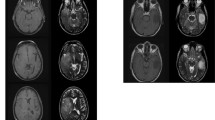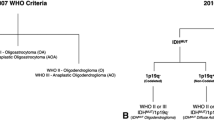Abstract
Introduction
The phenotypic heterogeneity of diffuse gliomas is still inconsistently explained by known molecular abnormalities. Here, we report the molecular and radiological features of diffuse grade WHO II and III gliomas involving the insula and its potential impact on prognosis.
Methods
Clinical, pathological, molecular and neuro-radiological features of 43 consecutive patients who underwent a surgical resection between 2006 and 2013 for a grade II and III gliomas involving the insula was retrospectively analyzed.
Results
Median age was 44.4 years. Eight patients had oligodendrogliomas, IDH mutant (IDHmut) and 1p/19q-codeleted (6 grade II, 2 grade III). Twenty-eight patients had diffuse astrocytomas, IDHmut (22 grade II and 6 grade III) and seven patients had grade II diffuse astrocytomas, IDHwt (A-IDHwt). Vimentin staining was exclusively recorded in tumor cells from A-IDHwt (p = 0.001). Mean cerebral blood volume (CBV) (p = 0.018), maximal value of CBV (p = 0.017) and ratio of the corrected CBV (p = 0.022) were lower for A-IDHwt. Volumetric segmentation of ADC allowed the identification of the tumor cores, which were smaller in A-IDHwt (p < 0.001). The tumor occurrences of A-IDHwt were exclusively located into the temporo-insular region. Median progression-free survival (PFS) and overall survival (OS) were 50.9 months (95% CI: 26.7–75.0) and 80.9 months (60.1–101.6). By multivariate analysis, A-IDHwt (p = 0.009; p = 0.019), 7p gain and 10q loss (p = 0.009; p = 0.016) and vimentin positive staining (p = 0.011; p = 0.029) were associated with poor PFS and OS respectively.
Conclusions
Insular low-grade A-IDHwt presented with poor prognosis despite a smaller tumor core and no evidence of increased perfusion on MR imaging.




Similar content being viewed by others
Change history
11 March 2019
In the initial, online publication, the authors' given names were captured as family names and vice versa. The names are correctly shown here. The original article has been corrected.
References
Smith JS, Perry A, Borell TJ et al (2000) Alterations of chromosome arms 1p and 19q as predictors of survival in oligodendrogliomas, astrocytomas, and mixed oligoastrocytomas. J Clin Oncol 18:636–645
Parsons DW, Jones S, Zhang X et al (2008) An integrated genomic analysis of human glioblastoma multiforme. Science 321:1807–1812. https://doi.org/10.1126/science.1164382
Yan H, Parsons DW, Jin G et al (2009) IDH1 and IDH2 mutations in gliomas. N Engl J Med 360:765–773. https://doi.org/10.1056/NEJMoa0808710
Louis DN, Perry A, Reifenberger G et al (2016) The 2016 World Health Organization classification of tumors of the central nervous system: a summary. Acta Neuropathol 131:803–820. https://doi.org/10.1007/s00401-016-1545-1
van den Bent MJ, Brandes AA, Taphoorn MJB et al (2013) Adjuvant procarbazine, lomustine, and vincristine chemotherapy in newly diagnosed anaplastic oligodendroglioma: long-term follow-up of EORTC brain tumor group study 26951. J Clin Oncol Off J Am Soc Clin Oncol 31:344–350. https://doi.org/10.1200/JCO.2012.43.2229
Buckner JC, Shaw EG, Pugh SL et al (2016) Radiation plus procarbazine, CCNU, and Vincristine in low-grade glioma. N Engl J Med 374:1344–1355. https://doi.org/10.1056/NEJMoa1500925
Stupp R, Mason WP, van den Bent MJ et al (2005) Radiotherapy plus concomitant and adjuvant temozolomide for glioblastoma. N Engl J Med 352:987–996. https://doi.org/10.1056/NEJMoa043330
Weller M, van den Bent M, Tonn JC et al (2017) European Association for neuro-oncology (EANO) guideline on the diagnosis and treatment of adult astrocytic and oligodendroglial gliomas. Lancet Oncol 18:e315–e329. https://doi.org/10.1016/S1470-2045(17)30194-8
Metellus P, Coulibaly B, Colin C et al (2010) Absence of IDH mutation identifies a novel radiologic and molecular subtype of WHO grade II gliomas with dismal prognosis. Acta Neuropathol 120:719–729. https://doi.org/10.1007/s00401-010-0777-8
Tabouret E, Nguyen AT, Dehais C et al (2016) Prognostic impact of the 2016 WHO classification of diffuse gliomas in the French POLA cohort. Acta Neuropathol 132:625–634. https://doi.org/10.1007/s00401-016-1611-8
Labussière M, Di Stefano AL, Gleize V et al (2014) TERT promoter mutations in gliomas, genetic associations and clinico-pathological correlations. Br J Cancer 111:2024–2032. https://doi.org/10.1038/bjc.2014.538
Feber A, Guilhamon P, Lechner M et al (2014) Using high-density DNA methylation arrays to profile copy number alterations. Genome Biol 15:R30. https://doi.org/10.1186/gb-2014-15-2-r30
Iglesias JE, Liu C-Y, Thompson PM, Tu Z (2011) Robust brain extraction across datasets and comparison with publicly available methods. IEEE Trans Med Imaging 30:1617–1634. https://doi.org/10.1109/TMI.2011.2138152
Mazziotta J, Toga A, Evans A et al (2001) A four-dimensional probabilistic atlas of the human brain. J Am Med Inform Assoc 8:401–430
Menze BH, Jakab A, Bauer S et al (2015) The multimodal brain tumor image segmentation benchmark (BRATS). IEEE Trans Med Imaging 34:1993–2024. https://doi.org/10.1109/TMI.2014.2377694
Duffau H, Capelle L (2004) Preferential brain locations of low-grade gliomas. Cancer 100:2622–2626. https://doi.org/10.1002/cncr.20297
Duffau H (2018) Surgery of insular gliomas. Prog Neurol Surg 30:173–185. https://doi.org/10.1159/000464393
Michaud K, Duffau H (2016) Surgery of insular and paralimbic diffuse low-grade gliomas: technical considerations. J Neurooncol 130:289–298. https://doi.org/10.1007/s11060-016-2120-2
Signorelli F, Guyotat J, Elisevich K, Barbagallo GMV (2010) Review of current microsurgical management of insular gliomas. Acta Neurochir 152:19–26. https://doi.org/10.1007/s00701-009-0450-y
Cancer Genome Atlas Research Network, Brat DJ, Verhaak RGW et al (2015) Comprehensive, integrative genomic analysis of diffuse lower-grade gliomas. N Engl J Med 372:2481–2498. https://doi.org/10.1056/NEJMoa1402121
Suzuki H, Aoki K, Chiba K et al (2015) Mutational landscape and clonal architecture in grade II and III gliomas. Nat Genet 47:458–468. https://doi.org/10.1038/ng.3273
Jiang H, Cui Y, Wang J, Lin S (2017) Impact of epidemiological characteristics of supratentorial gliomas in adults brought about by the 2016 world health organization classification of tumors of the central nervous system. Oncotarget 8:20354–20361. https://doi.org/10.18632/oncotarget.13555
Delfanti RL, Piccioni DE, Handwerker J et al (2017) Imaging correlates for the 2016 update on WHO classification of grade II/III gliomas: implications for IDH, 1p/19q and ATRX status. J Neurooncol 135:601–609. https://doi.org/10.1007/s11060-017-2613-7
Tejada Neyra MA, Neuberger U, Reinhardt A et al (2018) Voxel-wise radiogenomic mapping of tumor location with key molecular alterations in patients with glioma. Neuro-Oncol 20:1517–1524. https://doi.org/10.1093/neuonc/noy134
Yamauchi T, Ohno M, Matsushita Y et al (2018) Radiological characteristics based on isocitrate dehydrogenase mutations and 1p/19q codeletion in grade II and III gliomas. Brain Tumor Pathol. https://doi.org/10.1007/s10014-018-0321-4
Gaiano N, Fishell G (2002) The role of notch in promoting glial and neural stem cell fates. Annu Rev Neurosci 25:471–490. https://doi.org/10.1146/annurev.neuro.25.030702.130823
Riemenschneider MJ, Koy TH, Reifenberger G (2004) Expression of oligodendrocyte lineage genes in oligodendroglial and astrocytic gliomas. Acta Neuropathol 107:277–282. https://doi.org/10.1007/s00401-003-0809-8
Ehninger D, Kempermann G (2008) Neurogenesis in the adult hippocampus. Cell Tissue Res 331:243–250. https://doi.org/10.1007/s00441-007-0478-3
Quiñones-Hinojosa A, Chaichana K (2007) The human subventricular zone: a source of new cells and a potential source of brain tumors. Exp Neurol 205:313–324. https://doi.org/10.1016/j.expneurol.2007.03.016
Kurth F, Zilles K, Fox PT et al (2010) A link between the systems: functional differentiation and integration within the human insula revealed by meta-analysis. Brain Struct Funct 214:519–534. https://doi.org/10.1007/s00429-010-0255-z
Kurth F, Eickhoff SB, Schleicher A et al (2010) Cytoarchitecture and probabilistic maps of the human posterior insular cortex. Cereb Cortex 20:1448–1461. https://doi.org/10.1093/cercor/bhp208
Leu K, Ott GA, Lai A et al (2017) Perfusion and diffusion MRI signatures in histologic and genetic subtypes of WHO grade II-III diffuse gliomas. J Neurooncol 134:177–188. https://doi.org/10.1007/s11060-017-2506-9
Suh CH, Kim HS, Jung SC et al (2018) Imaging prediction of isocitrate dehydrogenase (IDH) mutation in patients with glioma: a systemic review and meta-analysis. Eur Radiol. https://doi.org/10.1007/s00330-018-5608-7
Villanueva-Meyer JE, Wood MD, Choi BS et al (2018) MRI features and IDH mutational status of grade II diffuse gliomas: impact on diagnosis and prognosis. AJR Am J Roentgenol 210:621–628. https://doi.org/10.2214/AJR.17.18457
Brat DJ, Aldape K, Colman H et al (2018) cIMPACT-NOW update 3: recommended diagnostic criteria for “Diffuse astrocytic glioma, IDH-wildtype, with molecular features of glioblastoma, WHO grade IV. Acta Neuropathol 136:805–810. https://doi.org/10.1007/s00401-018-1913-0
Funding
This work was supported by grants from Institut National du Cancer (Grant No. INCa-DGOS-Inserm 6038), from the Cancéropôle PACA (Grant No. 2015-02 INSUL802) and the GEFLUC Marseille Provence (Groupement Entreprises Françaises Lutte contre le Cancer—PVM-2014-241). We thank the AP-HM Tumor Bank (Authorization Number: AC2018-31053; CRB BB-0033-00097) for providing tissue samples. We also thank the ARTC-Sud patients’s association (Association pour le Recherche sur les Tumeurs Cérébrales).
Author information
Authors and Affiliations
Corresponding author
Ethics declarations
Conflict of interest
All authors declare that they have no conflict of interest.
Ethical approval
All procedures performed in studies involving human participants were in accordance with the ethical standards of the institutional and/or national research committee and with the 1964 Helsinki declaration and its later amendments or comparable ethical standards.
Informed consent
Informed consent was obtained from all individual participants included in the study.
Additional information
Publisher’s Note
Springer Nature remains neutral with regard to jurisdictional claims in published maps and institutional affiliations.
The orignal version of this article has been revised: The format of the authors' names has been corrected.
Electronic supplementary material
Below is the link to the electronic supplementary material.
Rights and permissions
About this article
Cite this article
Compes, P., Tabouret, E., Etcheverry, A. et al. Neuro-radiological characteristics of adult diffuse grade II and III insular gliomas classified according to WHO 2016. J Neurooncol 142, 511–520 (2019). https://doi.org/10.1007/s11060-019-03122-1
Received:
Accepted:
Published:
Issue Date:
DOI: https://doi.org/10.1007/s11060-019-03122-1




